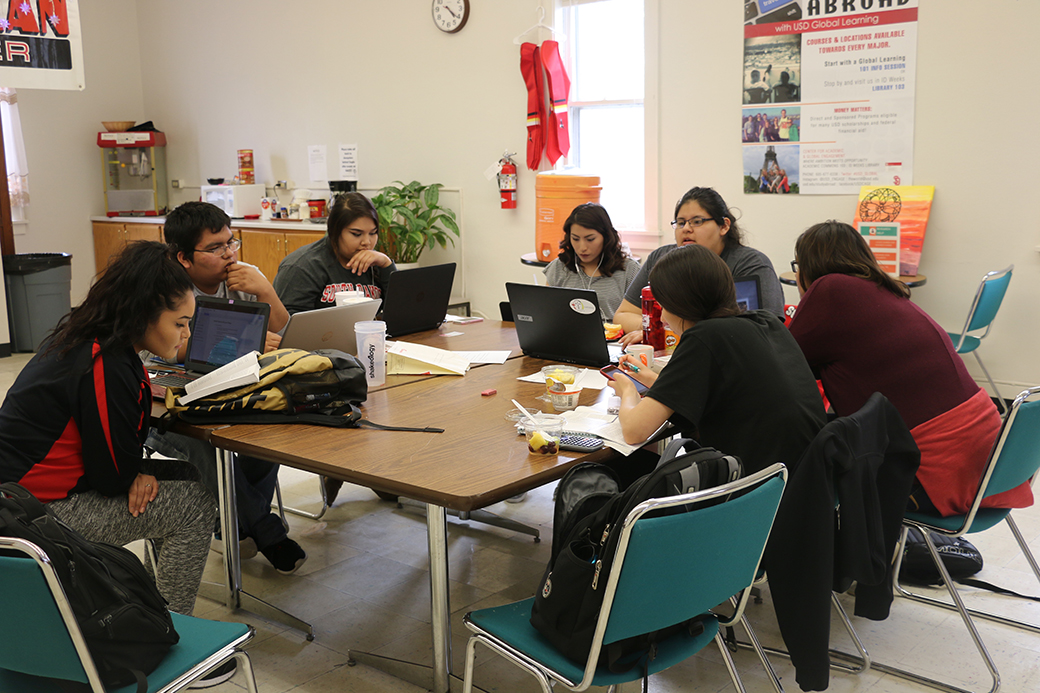
Native American Cultural Center acts as second home for students
Ask the students who spend their time at the Native American Cultural Center what they think about it, and they’ll tell you USD wouldn’t be the same without it.
Gene D. Thin Elk, director of Native Studies, said the center is a place where students can feel connected to their culture without leaving USD.
“They can interact with students who are from different parts of the country — even amongst the Native population, we’re very diverse,” Thin Elk said. “It gives an opportunity to interact, but there are some basic beliefs, values, lifestyles and a sense of identity that’s really enhancing with them being around people that you don’t have to explain things to.”
The original Native American Cultural Center was established in 1980, a gift from a local realtor to “have a place where Native students can gather,” Thin Elk explained.
Thin Elk has worked at the center for 29 years.
“It gives an opportunity for our Native students to be able to have a place that they can call home,” he said.
Students said they have welcomed this “homey” feeling.
“This place is like home,” sophomore and center employee Carmelita Shouldis said. “It’s just so comfortable here and everyone’s always open-minded and it feels loving here. It would be a lot different if it wasn’t here.”
Sophomore Maria Limon has similar feelings about the center’s atmosphere.
“I remember when I first came here, as soon as I walked in, there was a warm feeling,” Limon said. “If it wasn’t for this place, I would be cooped up in my room.”
Students that go to the center are not only able to be with fellow peers, but also to use the center as a resource and learning environment. The center has a computer lab and hosts classes primarily based on indigenous perspectives and tutoring.
Besides a place for conjugating and studying, the Native American Cultural Center also provides a space for different organizations associated with Native Student Services to meet, such as Tiospaye, Sundance Society meetings and drum groups for students.
Activities also include inviting speakers and performers to visit, a Lakota language table, holiday-related activities and tutors for different subjects.
Thin Elk said the space allows students and faculty to acknowledge and appreciate Native American culture, rather than compromising or hiding it.
“I think the center is essential to USD,” Thin Elk said. “When you’re talking about diversity, you’re talking about recognizing the differences in the populations that you serve, but when you’re talking about inclusion, you’re talking about what the differences are and what you need to develop as services to provide for those populations.”
Donis Drappeau, the center’s program coordinator, said he enjoys interacting with students and helping them feel comfortable.
“It empowers them, and they feel comfortable here,” Drappeau said. “It also keeps me young.”
Students, also find that the staff members encourage them to do their best in school.
“It has a big impact on staying in school,” Limon said. “Before I worked here, all the staff and everybody was encouraging… I’m definitely here because Gene and all the staff… it’s the reason I don’t want to transfer, the reason I want to stay in school, because of this place.”
Helping and getting to know students are just a couple of ways the Native American Cultural Center has impacted Thin Elk.
He said the center teaches students to how showcase themselves and reach out into the professional world. The directors appreciate being a part of these students’ success, he added.
“Having the opportunity to work with future professionals that will impact this world in wonderful, amazing ways, in that way, even if I’m not around, I still had some kind of impact because of these awesome students. That’s exciting,” Thin elk said. “That’s part of our culture — we give back when we receive something.”

